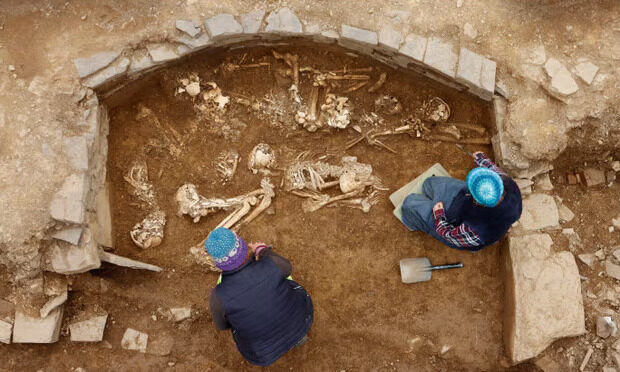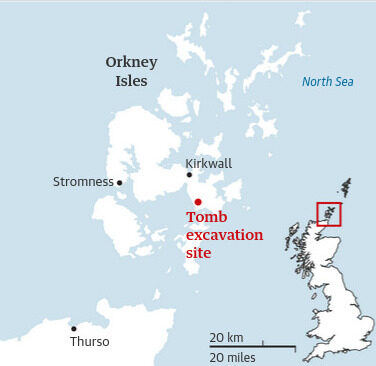
Fourteen articulated skeletons of men, women and children - two positioned as if they were embracing - have been found inside one of six cells or side rooms.
The tomb measures more than 15m in diameter and contains a stone structure accessed through a long passage of around seven metres. The excavation was headed by Dr Hugo Anderson-Whymark, senior curator of prehistory (neolithic) at the National Museums Scotland, and Vicki Cummings, professor of neolithic archaeology at Cardiff University.
Anderson-Whymark recalled the "incredible excitement" as they removed topsoil and could see the outline plan of this tomb, a circular shape with a rectangular chamber surrounded by six cells with curved backs. He said: "Seven or eight metres across the interior is really big. We had found not only the tomb, but then in situ articulated skeletons - the icing on the cake."
He noted that the corbelled construction involved stones being built up gradually to create cell chambers that narrowed as they rose: "They really are engineering feats. The tomb would have been an immense feature in the landscape when it was originally constructed, and the stonework inside would have been very impressive."
The site had been overlooked until now as it was flattened and largely destroyed without record in the 18th or 19th centuries when stone was used for a nearby building that was demolished about a decade ago.
Further digging in the ruins by a farmer's son in 1896 revealed traces of walling and the discovery of a stone macehead and ball, as well as eight skeletons. These discoveries were reported in a local paper by an antiquary, James Walls Cursiter, who speculated that it was a ruined tomb but did not realise its significance or age, having only seen part of it.
Described then as a "chambered cairn", it received a mere couple of paragraphs, which Anderson-Whymark happened to spot during other research. It inspired him to track down the site. With the assistance of students from the University of Central Lancashire and local volunteers, a three-week excavation at Holm, East Mainland, unearthed evidence of a substantial cairn.
Most neolithic tombs survive as upstanding monuments in Orkney, but the Holm tomb was buried beneath green rolling fields.
Anderson-Whymark said: "Orkney is exceptionally rich in archaeology, but we never expected to find a tomb of this size in such a small-scale excavation. It's incredible to think this once impressive monument was nearly lost without record."
Cummings added: "It is incredibly rare to find these tomb deposits, even in well-preserved chambered tombs, and these remains will enable new insights into all aspects of these peoples' lives."
A small motif - three lines and other scratch marks carved on the back of one of the stones - has survived.
Through DNA analysis and other research, there is now the potential to discover if the individuals buried there were all related and their link to other Orkney tombs, some of which might have been used over generations or hundreds of years.
Anderson-Whymark said: "They were certainly putting bodies on top of bodies, but they appear to have gone in over a period of time."
The entrance could have been blocked with a slab of stone, allowing them to go back in, perhaps for various activities and ceremonies within the main chamber.
The tomb dates from around 3000 BC, when local communities had been farming in Orkney for several hundred years. They focused on cattle, and thousands of years later, the field is still used for cattle.




Comment: See also: